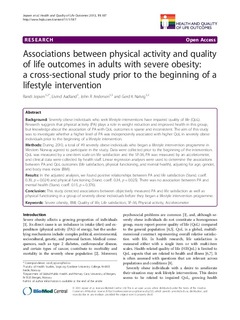| dc.description.abstract | Background: Severely obese individuals who seek lifestyle interventions have impaired quality of life (QoL). Research suggests that physical activity (PA) plays a role in weight reduction and improved health in this group, but knowledge about the association of PA with QoL outcomes is sparse and inconsistent. The aim of this study was to investigate whether a higher level of PA was independently associated with higher QoL in severely obese individuals prior to the beginning of a lifestyle intervention.
Methods: During 2010, a total of 49 severely obese individuals who began a lifestyle intervention programme in Western Norway agreed to participate in the study. Data were collected prior to the beginning of the intervention. QoL was measured by a one-item scale on life satisfaction and the SF-36, PA was measured by an accelerometer, and clinical data were collected by health staff. Linear regression analyses were used to determine the associations between PA and QoL outcomes (life satisfaction, physical functioning, and mental health), adjusting for age, gender, and body mass index (BMI).
Results: In the adjusted analyses, we found positive relationships between PA and life satisfaction (Stand. coeff. 0.39, p = 0.024) and physical functioning (Stand. coeff. 0.34, p = 0.025). There was no association between PA and mental health (Stand. coeff. 0.15, p = 0.376).
Conclusion: This study detected associations between objectively measured PA and life satisfaction as well as physical functioning in a group of severely obese individuals before they began a lifestyle intervention programme. | no_NO |
